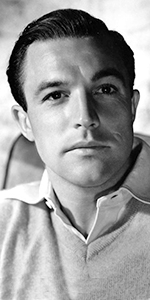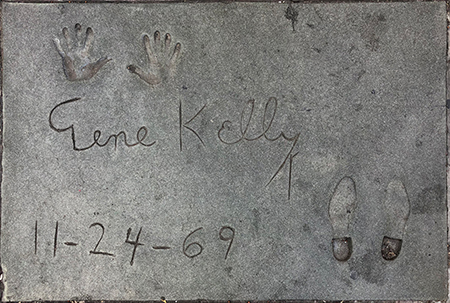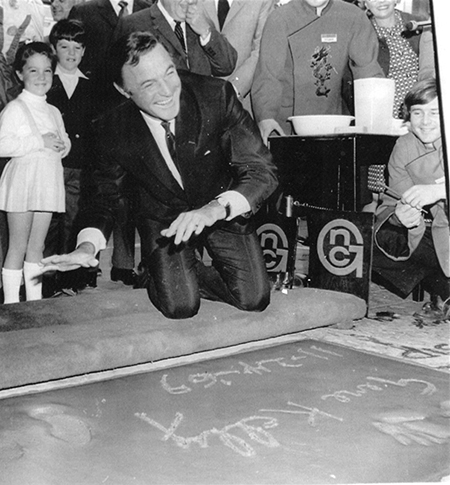 |
 |
 |
 |
 |
| Gene Kelly, circa 1944. Photo by Clarence Sinclair Bull (1896-1979). |
| |
|
 |
|
 |
| |
 |
| |
 |
| |
 |
| |
 |
| |
|
|
| Gene Kelly |
 |
| Forecourt Ceremony held on Monday, November 24, 1969 |
| |
Born: August 23, 1912, in Pittsburgh, Pennsylvania
Age at the time of the ceremony: 57
Died:
February 2, 1999, in Beverly Hills, California, age 83
|
| |
Gene Kelly was was a key figure in the musical films of the postwar era and into the 1960s. Kelly brought a powerful dancing ability, combined with a pleasent singing voice and charming sincerity to all of his film work, making him popular with men as well as women.
Born from Irish-German
stock, Gene and his older brother James were enrolled in dance class when he was eight. Both Kelly boys got beat up by the neighborhood bullies. Wanting to become a shortstop, Gene developed into a tough kid. After graduating high school, Kelly attended Pennsylvania State College as a journalism major, but the Stock Market Crash put an end to that. Quitting school, Gene and younger brother Fred danced in local nightclubs to help with the family budget.
By 1931, Kelly was at the University of Pittsburgh studying economics; while there, he became involved with their musical offerings, rising to become the director of the Cap and Gown Club. In the meantime, Kelly's parents opened a dance studio in Pittsburgh, with Gene being a primary teacher there. This kept on until Kelly departed for New York City, hoping to become a choreographer, in 1937.
New York wasn't buying, so Kelly returned to Pittsburgh, starring in shows at the Pittsburgh Playhouse. His director there was Robrt Alton, who brought Kelly to Broadway to be in Cole Porter's musical starring Mary Martin, Leave It To Me! for 291 perfs, from November 1938, to July 1939. Kelly's breakthrough role was The Time of Your Life, for 185 perfs, from October 1939, to April 1940, for which Kelly both starred and choreographed. He was asked to be house chroreographer at Billy Rose's Diamond Horseshoe, a nightclub in Manhattan. Kelly got married to one of the chorins who worked there, Betsy Blair, in October 1941.
Kelly got the lead in the Rogers and Hart musical Pal Joey, opposite Vivienne Segal, for 340 perfs, from December 1940, to October 1941. His perfectionist streak in his dancing made him an overnight star. Offers from Hollywood began to swirl about, but before leaving New York and Pal Joey, he choreographed one more show Best Foot Forward, opening in October 1941.
Producer David O. Selznick put Kelly under contract, selling half of it to M-G-M, where Kelly would work for the next decade. His first film,
For Me and My Gal (which played the Chinese in November 1942), with Judy Garland, was such a success, that M-G-M producer Arthur Freed bought the other half of Kelly's Selznick contract. After a couple of pre-booked loan-outs, Kelly was in Du Barry Was a Lady (which played the Chinese in July 1943), with Red Skelton, and Thousands Cheer (which played the Chinese in December 1943), with Katheryn Grayson.
At Columbia, Kelly made a strong impression in
Cover Girl (released in April 1944), with Rita Hayworth. Back at M-G-M, Kelly really wowed 'em with his dance number with animated characters Tom and Jerry in Anchors Aweigh (released in August 1945), with Frank Sinatra. Kelly danced for the only time with Fred Astaire in a number from Ziegfeld Follies (released in April 1945), with William Powell.
Director Vincente Minnelli knew that Kelly was busting to make a more robust musical, and gave him the chance in
The Pirate (released in June 1948), with Judy Garland, but the lavish and imaginative film was "soft" at the box-office. To regain lost ground, he played D'Artagnan in The Three Musketeers (released in October 1948), with Lana Turner, which is a love-it-or-hate-it movie. Kelly's next, Take Me Out to the Ball Game (released in April 1949), with Frank Sinatra, was a success, with Kelly helping to shape the movie — wanting to direct.
He got his chance with
On the Town (released in December 1949), with Frank Sinatra; Kelly co-directed the picture with Stanley Donen, which featured Kelly, Sinatra and Jules Munson dancing around New York locations. The film was a whopping hit. Kelly was now in the driver's seat. Always having been a Franchophile, Kelly and director Vincente Minnelli pulled together a musical from the George Gershwin songbook, and designed a lavish ballet to accompany Gershwin's tone poem, An American in Paris (released in November 1951), with Leslie Caron. Not only was the film popular, it bagged the Oscar for Best Picture.
Kelly and Donen had one more masterpeice up their sleeve, however. Singin' in the Rain (released in April 1952), with Donald O'Connor and Debbie Reynolds, is a musical about the early days of the talkies in Hollywood, and is, even for people who dislike musicals, a thoroughgoing delightful entertainment. For all three of its stars, the film contains their signature roles.
Kelly and Minnelli weren't so lucky with their film of
Brigadoon (released in September 1954), with Van Johnson, but the film is well-liked by some. It's Always Fair Weather (released in September 1955), with Dan Dailey, is a follow-up of sorts to On the Town. Kelly attempted a ballet film with Invitation to the Dance (released in May 1956), with Tamara Toumanova, but the film crashed at the box-office. Les Girls (released in October 1957), with Mitzi Gaynor, was his last musical for M-G-M. An era had come to a close.
Turning to other projects, Kelly undertook a dramatic role in
Marjorie Morningstar (released in April 1958), with Natalie Wood, then returned to Broadway to direct the Rogers and Hammerstein musical Flower Drum Song; the wildly popular production starred Miyoshi Umeki and Keye Luke, and opened in December 1958, running until May 1960, for 600 perfs. With Flower up and running, Kelly played a cynical newspaper reporter in Inherit the Wind (which played the Chinese in November 1960), with Spencer Tracy and Fredric March.
Always a sucker for anything French, Kelly next directed a mute Jackie Gleason
in Gigot (released in November 1962), but it was cut by its studio and flopped anyway. Kelly did his first television show, taking on Bing Crosby's role in Going My Way for 30 episodes, airing over ABC from October 1962, to April 1963. Returning to the big screen, he played one of Shirley MacLaine's husbands in What a Way to Go! (released in May 1964).
Kelly as a solo director provided a solid hit for
Walter Matthau: A Guide for the Married Man (released in May 1967). He directed the hugely-expensive film of Hello, Dolly! (which played the Chinese in December 1969), starring Barbra Streisand, and directed The Cheyenne Social Club (released in June 1970), starring James Stewart and Henry Fonda.
Kelly accepted roles in various pictures, such as playing Liv Ullman's ex in
40 Carats (released in June 1973), and appeared in the notorious bomb-turned-camp-classic Xanadu (released in August 1980), with Olivia Newton-John. His final turn was in Sins (aired over CBS, in February 1986, with Joan Collins.
In declining health, Kelly suffered a stroke in 1994 and again in 1995. He died in his sleep at home in February 1996 at the age of 83. |
|
|
|
|
| |
 |
 |
| Grauman's Chinese Theatre, Hollywood, California. Gene Kelly Forecourt block. Executed by John Tartaglia, on Monday, November 24, 1969. 58 x 38 inches. |
 |
 |
 |
| Grauman's Chinese Theatre, Hollywood, California. Gene Kelly Forecourt ceremony, Monday, November 24, 1969. Daughter Bridget and son Timothy stand by as Gene Kelly savors the moment. |
|
 |
| |
 |
| |
|